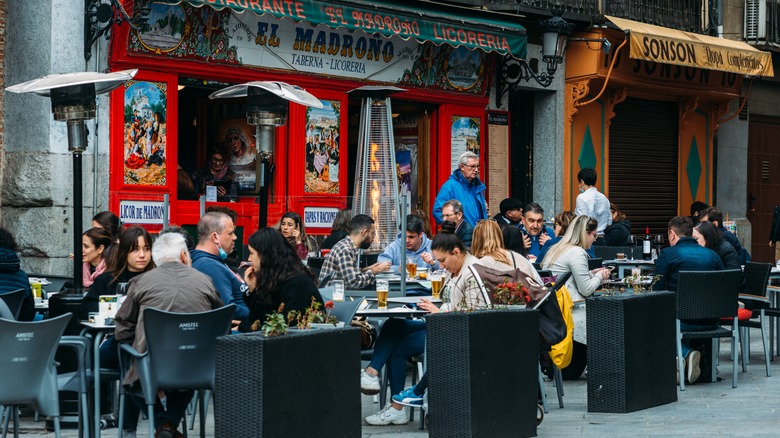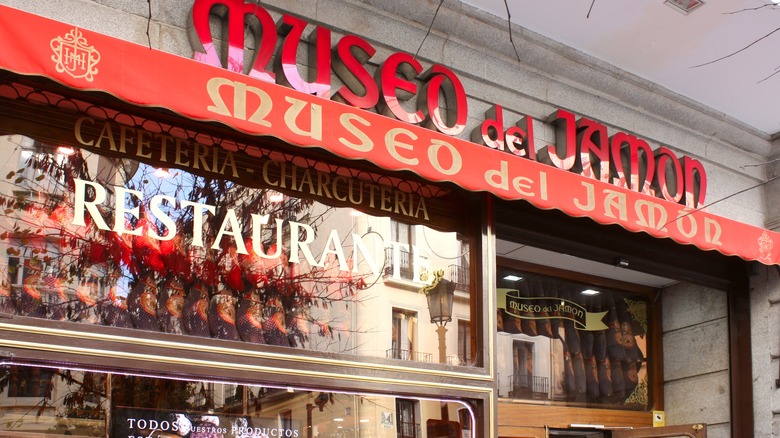Is It Actually Common To Throw Olive Pits On The Floor In Spanish Bars?
When it comes to boasting a long list of underrated coastal cities and picture-perfect scenic villages, Spain is always ready to shine. With its vibrant culture, mouthwatering food scene, and everything from white sand beaches to lush mountain regions, the European country is a melting pot of experiences that draws in more than 80 million yearly visitors from all over the world.
However, between all of the potential sightseeing and exploring waiting for you, there are certain local customs and traditions that might leave foreign travelers feeling a little ... confused. One of these is the supposedly-normal practice of simply throwing your trash — from used napkins to bits of food — directly on the floor while enjoying a lively night of tapas (traditional sharing plates and snacks) and cañas (small glasses of beer served on tap) with the locals. This is sometimes said to be a hallmark of a traditional local bar or eatery in Spain, but is that actually the case?
Well, the answer is ... it depends. Nowadays, most restaurants have put their olive-pits-on-the-floor days behind them — especially after COVID-19, where cleanliness took such a high priority. Nonetheless, you might still find a hyper-local joint that doesn't mind a little litter.
Olive pits and napkins on the floor are mostly a no-go
According to the locals I spoke to — both diners and bartenders around Madrid — dropping your olive pits on the floor hasn't really been a thing for the past few years. To counter this, most eateries and bars will now bring out two separate plates when they serve your table a round of olives: one with the snack itself, and another for the pits.
"The 'cultura' is changing," a local friend who's lived in Madrid for the past 18 years told me. "I used to see it more often, like five or more years ago. Today, it doesn't really happen. Many restaurants don't allow it." In fact, some local governments have also gone as far as fining restaurateurs who fail to keep their floors clean — a strict measure that has ultimately killed the tradition.
However, there are still some spots — like the popular Museo del Jamón in Madrid, which specializes in local hams — that still welcome patrons who casually drop their garbage on the floor every so often. That said, the restaurant — which has been operating since 1978 and seems pretty stuck on its ways of doing things — is just one of the few exceptions out there.
Other Spanish dining customs to keep in mind
Aside from whether or not to drop your trash on the floor, Spain has plenty of other dining customs and traditions to keep in mind. For starters, there's the tradition of eating late. While most Americans are used to earlier mealtimes, Spaniards typically have lunch around 2 or 3 p.m., and dinner around 9 or 10 p.m. This is especially common during the summer, where the sun starts to set after 9 p.m. in most parts of the country.
Along with this, there's also Spain's cigarette-friendly culture — so don't be alarmed when you see nearby diners smoking at the table, especially if they're sitting outside. As a heads up, most establishments typically have an unspoken rule that outdoor seating is generally smoker-friendly. If you can't handle the smoke, it's best to choose a table inside.
Oh, and whatever you do, make sure you never hit up a local Spanish joint and ask for a jug of sangria. While the wine and fruit combo might be widely known by outside visitors, you'll rarely see locals drinking it, because it's precisely this popularity that has made it incredibly overpriced. Instead, do yourself a favor and ask for a "tinto de verano," or "summer red." It's similar to the original, but with less booze, a lot easier to make, and much cheaper, too.


